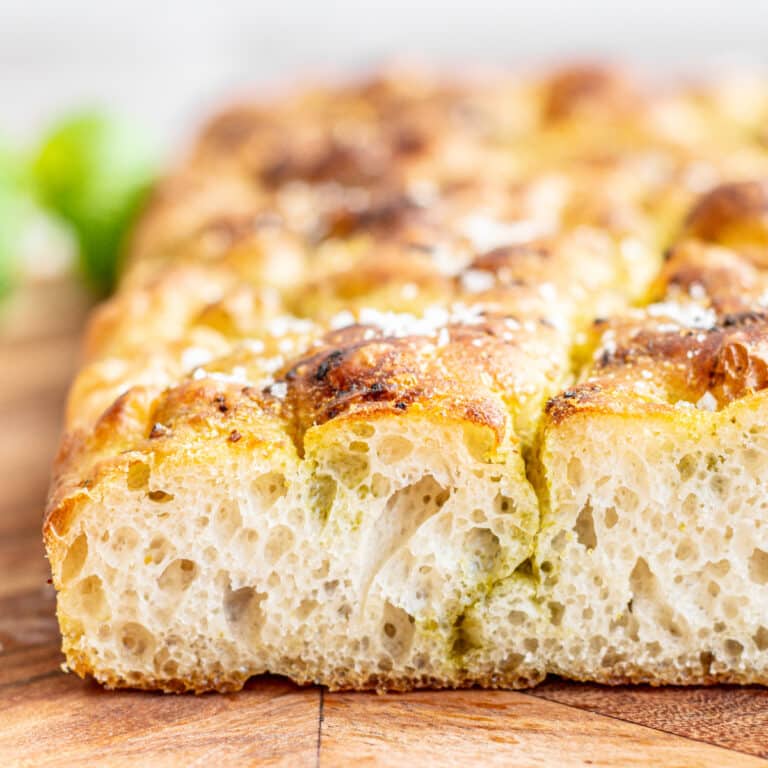Sourdough Hot Cross Buns
These sourdough hot cross buns are fluffy, perfectly spiced, and filled with raisins and orange zest. These are perfect for enjoying on Good Friday.
These are traditional hot cross buns made with a sourdough starter, so there is no need for commercial yeast.

About these hot cross buns
It’s an enriched dough with egg and butter. The dough is sticky and can be mixed in a stand mixer or worked by hand through simple stretches and folds. This is a great way to bring strength to the dough and takes little effort.
The dough is spiced with cinnamon, cloves, ginger, and nutmeg. Fresh orange juice, zest, and raisins bring some sweetness and texture.
If you’re not a fan of fruit in your hot cross buns, try these sourdough hot cross buns with chocolate chips instead!
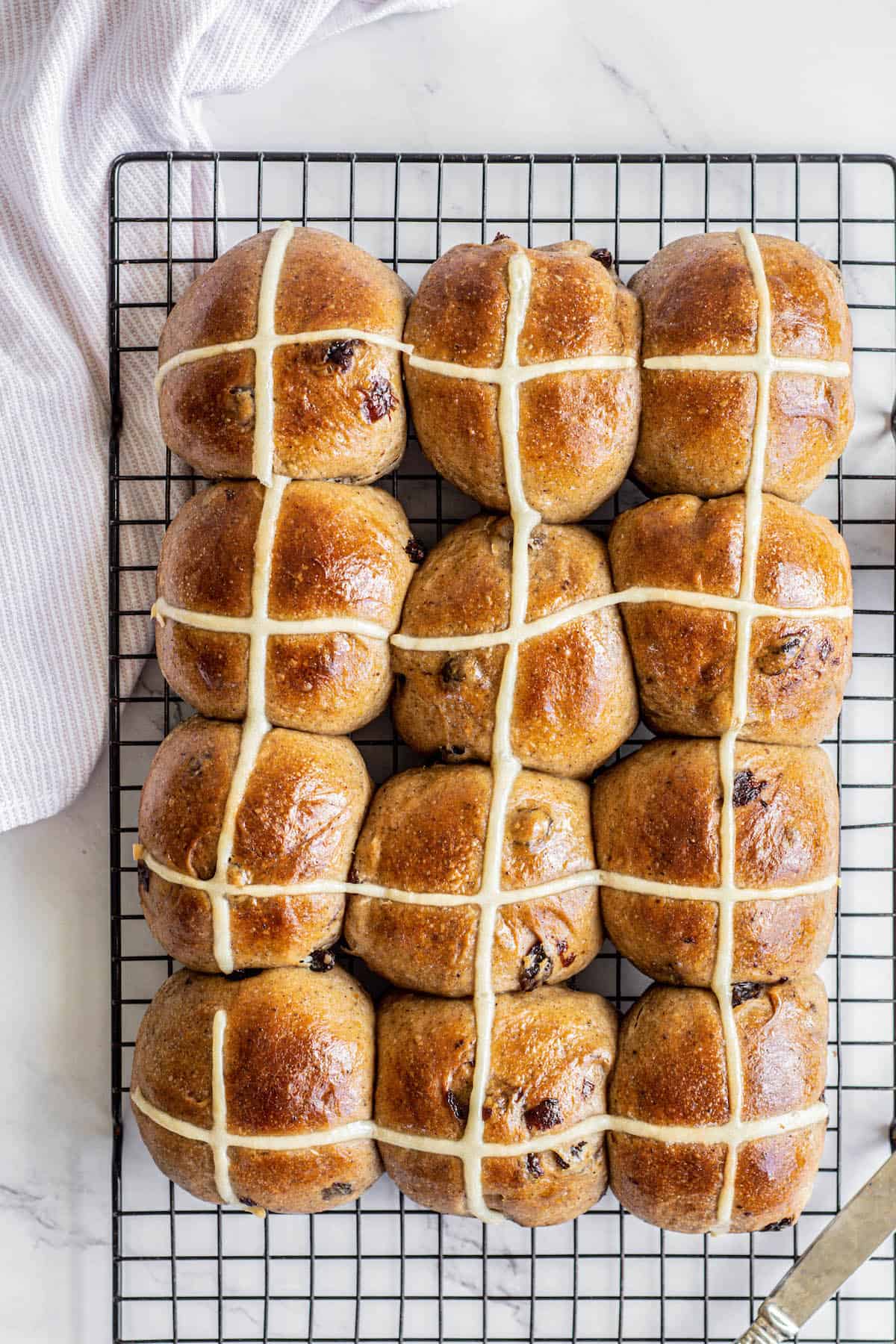
Ingredients
For this sourdough hot cross buns recipe, you will need –
- Strong all-purpose flour with a protein level of at least 11%, or bread flour
- An active sourdough starter
- Whole milk
- Soft brown sugar
- A large egg
- Spices – cinnamon, cloves, ginger, and nutmeg.
- Salt
- Butter – unsalted butter or salted
- Orange peel and orange juice (or add in some homemade candied lemon peel)
- Raisins or currants
- Granulated sugar for the topping glaze.
- The hot cross bun crosses are made of equal parts water and flour, but you can also use your sourdough discard starter for that part.
I’ve got recipes for hot cross buns with regular yeast too! Chocolate hot cross buns, traditional hot cross buns or orange chocolate hot cross buns.

Sourdough starter
To make this hot cross bun recipe, you need an active sourdough starter. If you don’t have one, here is how to make your own sourdough starter.
If you have one, feed and discard on a regular basis to keep the acid content in the starter low. Too much acid can affect the structure of the dough.
The sourdough starter is fed overnight at a ratio of 1:3:3 (or even 1:4:4 if it’s going to be a warm night). This means a ratio of 1 part starter, three parts flour, and three parts water measured in weight.
This feeding amount means it will be ready to use within 8-10 hours, depending on the room’s warmth overnight. If I use it sooner, within 6 hours, I will feed it 1:2:2.
If your starter is pretty young, it will help to keep it in a warm space overnight when feeding it at a higher ratio. A 1:3:3 feeding example would be 20 g starter, 60 g flour, and 60 g water.

Method
The evening before
Combine the starter ingredients in a small bowl and mix them well. Tip the mixture into a clean jar. Leave it on the bench to rise overnight and cover the jar with a tea towel or loosely balanced lid.
The following morning

Add the raisins, orange juice and zest to a small bowl and stir.
Leave to sit for at least 30 minutes so the raisins can hydrate.

Mix flour, spices, salt, and sugar in a large bowl.
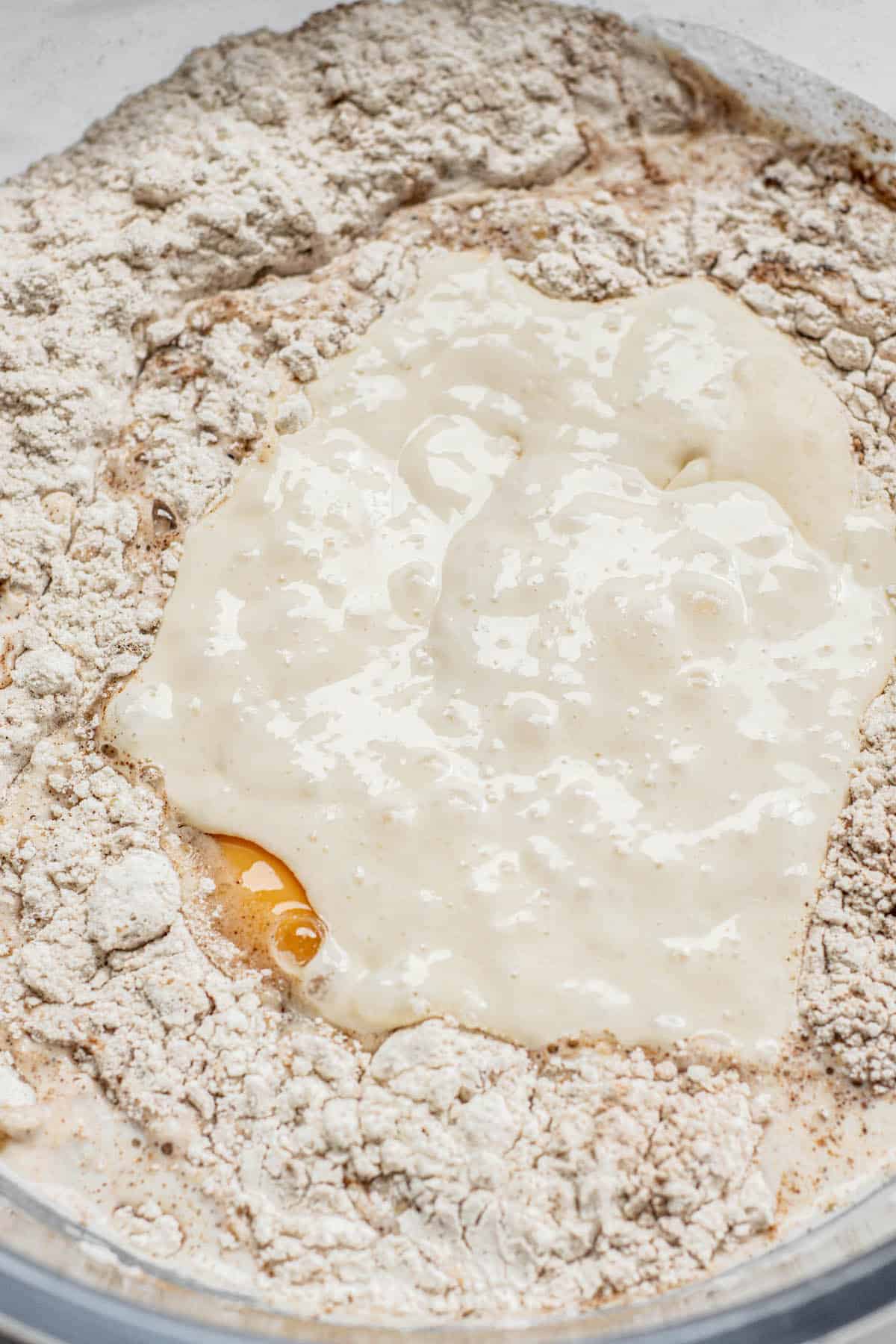
Add in the milk, egg, and sourdough starter. Use a fork to combine it into a shaggy dough first, then switch to using your hands.
If you have a stand mixer fitted with a dough hook attachment, by all means, use that
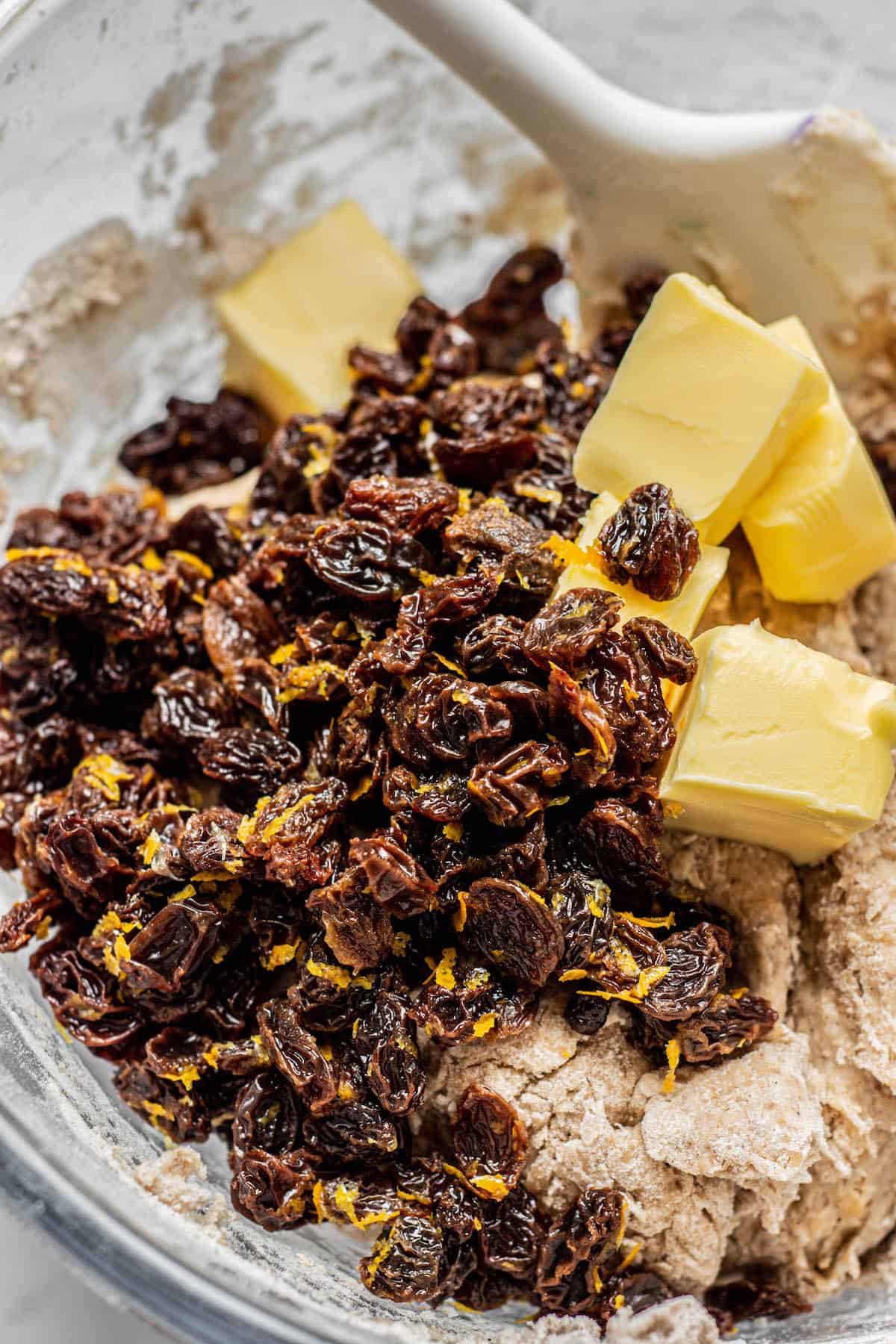
Add softened butter and the bowl of raisins, orange juice, and zest. Use your hands to squish everything together until the butter is incorporated.
Once the butter has been mixed in, transfer the sticky dough to a clean and lightly greased bowl.
Stretch and folds
Over the next two hours, perform 4-5 sets of stretch and folds. One every 20 minutes or so. A stretch and fold method stretches one side of the dough and pulls it over itself.
The bowl is then turned a quarter turn, and this move is repeated on the following side. Continue stretching, folding, and turning the bowl until all sides have been folded. You can do a few extra turns if needed. That is ‘one set’ of stretch and folds.
Over time the spiced dough will gather strength.

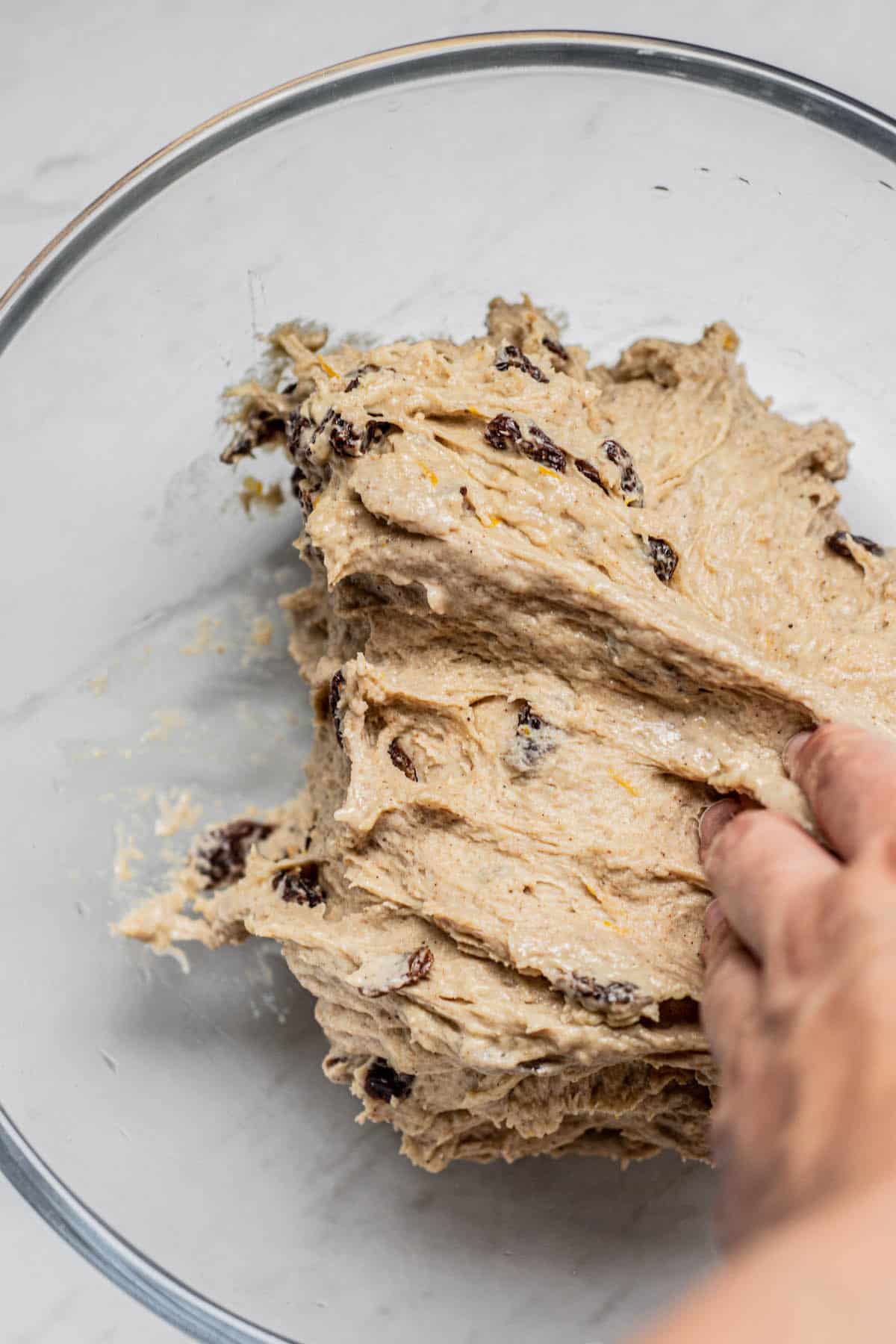
Bulk fermentation
After the folding, cover the dough with plastic wrap or a damp cloth and let it rise in a warm spot, ideally at around 77°F/25°C, until bulked out by around 50%.
You can create a warm and humid spot for this bulk rise by placing the dish into a lightly pre-heated (no more than 40°C/104°F), then turned-off oven alongside a large cup of boiled water.
After this, place the dough in the refrigerator in an airtight container.

Cold Proofing – Two Options
Now you have two options depending on when you want to eat and serve the sourdough hot cross buns.
Option 1– Let the dough sit in the fridge for the rest of the day, then in the evening, remove it and shape the buns. Cover them with a damp tea towel or plastic wrap and let them rise overnight for 10-12 hours at room temperature. They can be baked fresh in the morning.
Option 2 – The dough can be refrigerated overnight; the next day, the buns can be shaped and have their final rise. Then they can be baked for fresh buns at midday or afternoon.
Shaping hot cross bun dough
Tip the dough onto a lightly floured work surface and cut it into 12 equal pieces.

Dust your hands with flour if needed and form each piece into a ball, tucking the edges underneath to create a bit of surface tension.

Place the dough balls into a greased or lined 9×13 inch dish and let them proof until doubled.
Piping the traditional cross
Mix the flour paste for the crosses until it makes a thick paste. You can also use sourdough discard starter as the paste.
Pipe crosses on the buns using a piping bag with a small round tip.
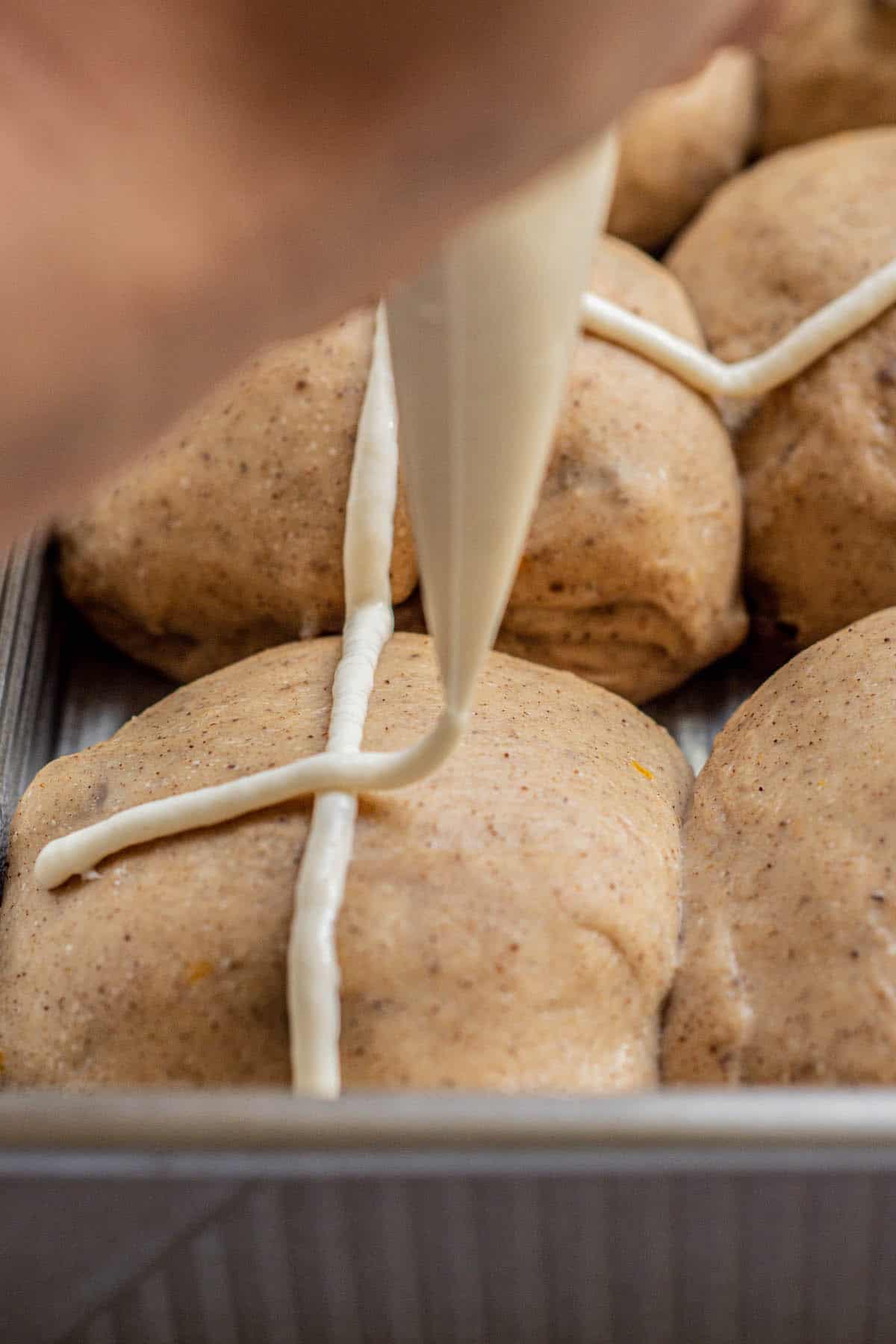
Baking
Preheat the oven to 350°F (180°C.)
Bake the buns for around 28-30 minutes until they are a deep golden brown. Egg wash is unnecessary for these buns; they’ll be glazed in sugar syrup after baking.
While baking, mix hot water and sugar to make the sugar glaze ingredients. When the hot cross buns come out of the oven, use a pastry brush to brush them with the glaze.
Let them cool for 5-10 minutes before removing them and cooling them further on a wire rack.

Serving and storing
Serve the sourdough hot cross buns fresh, with a pat of butter.
Leftover sourdough hot cross buns can be covered and stored at room temperature for up to three days. Alternatively, the baked buns can also be frozen for up to three months.

More sourdough recipes

Fluffy Sourdough Hot Cross Buns
These sourdough hot cross buns are fluffy, perfectly spiced, and filled with raisins and orange zest. These are perfect for enjoying on Good Friday.
Ingredients
Sourdough starter
- 25g sourdough starter
- 60g all-purpose flour
- 60g water
Fruit
- 100g (1/2 cup) raisins
- 60g (1/4 cup) orange juice
- 1 Tablespoon finely grated orange zest
Dough
- 500g (4 cups*) all-purpose flour
- 65g (1/3 cup) soft brown sugar
- 1 tsp salt
- 2 1/2 tsp ground cinnamon
- 1/2 tsp ground cloves
- 1/2 tsp ground ginger
- 1/4 teaspoon ground nutmeg
- 1 large egg
- 240g (1 cup) whole milk
- All the sourdough starter
- 60g (4 tbsp) butter, softened
Crosses
- 40g (5 Tablespoons) all-purpose flour
- 40g (3 Tablespoons) water
Sugar Glaze
- 50g (1/4 cup) granulated sugar
- 40g (3 Tablespoons) boiled water
Instructions
The evening before
- Combine the starter ingredients in a small bowl and mix them well. Tip the mixture into a clean jar. Leave it on the bench to rise overnight and cover the jar with a tea towel or loosely balanced lid.
The following morning
- Heat the orange juice in a saucepan and add the dried fruit and orange peel. Leave to sit for at least 30 minutes so the raisins can hydrate.
- Mix flour, spices, salt, and sugar in a large bowl. Add in the milk, egg, and sourdough starter. Use a fork to combine it into a shaggy dough first, then switch to using your hands.
- Add softened butter, soaked raisins, orange juice, and zest. Use your hands to squish everything together until the butter is incorporated. The spiced dough will be very sticky. Once the butter has been mixed in, transfer this sticky dough to a clean and lightly greased bowl.
Stretch and folds
- Perform 4-5 sets of stretches and folds over the next two hours. One every 20 minutes or so.
- A stretch and fold method stretches one side of the dough and pulls it over itself. The bowl is then turned a quarter turn, repeated on the following side. Continue stretching, folding, and turning the bowl until all sides have been folded. You can do a few extra turns if needed. That is 'one set' of stretch and folds. (The dough can also be mixed in a stand mixer with a dough hook for 10 minutes.)
Bulk fermentation
- After the folding, cover the dough with plastic wrap or a damp cloth and let it rise in a warm spot, ideally at around 77°F/25°C, until bulked out by around 50%.
- After this, place the covered dough in the refrigerator.
Cold Proofing - Two Options
- Option 1- Let the dough sit in the fridge for the rest of the day, then in the evening, remove it and shape the buns. Cover them with a damp tea towel or plastic wrap and let them rise overnight for 10-12 hours at room temperature. They can be baked fresh in the morning.
- Option 2 - The dough can be refrigerated overnight; the buns can be shaped the next day and have their final rise. Then they can be baked for fresh buns at midday or afternoon.
Shaping hot cross bun dough
- Tip the dough onto a lightly floured work surface and cut it into 12 equal pieces.
- Dust your hands with flour if needed and form each piece into a ball, tucking the edges underneath to create surface tension.
Final proof
- Place the dough balls into a greased or lined 9x13 inch dish and let them proof overnight until doubled. If you're not proving overnight, let them rise during the day in a warm spot (ideally at 77°F/25°C) for 5-8 hours until doubled in size.
- Mix the flour paste for the crosses until it makes a thick paste. You can also use sourdough discard starter as the paste.
- Pipe crosses on the buns using a piping bag with a small round tip.
- Preheat the oven to 350°F/180°C.
Baking
- Bake the buns for around 28-30 minutes until they are a deep golden brown. Egg wash is unnecessary for these buns; they'll be glazed in sugar syrup after baking.
- Mix hot water and sugar to make the sugar glaze ingredients while baking. When the hot cross buns come out of the oven, use a pastry brush to brush them with the glaze.
- Let them cool for 5-10 minutes before removing and cooling them further on a wire rack.
Notes
*The cup sizes given are for US cups. Note that these are smaller than metric cup sizes. For best results, use grams.
Nutrition Information:
Yield: 12 Serving Size: 1Amount Per Serving: Calories: 300Total Fat: 5gSaturated Fat: 3gTrans Fat: 0gUnsaturated Fat: 2gCholesterol: 27mgSodium: 244mgCarbohydrates: 56gFiber: 3gSugar: 10gProtein: 8g
This is an informational estimate only. I am not a certified Dietitian or Nutritionist


